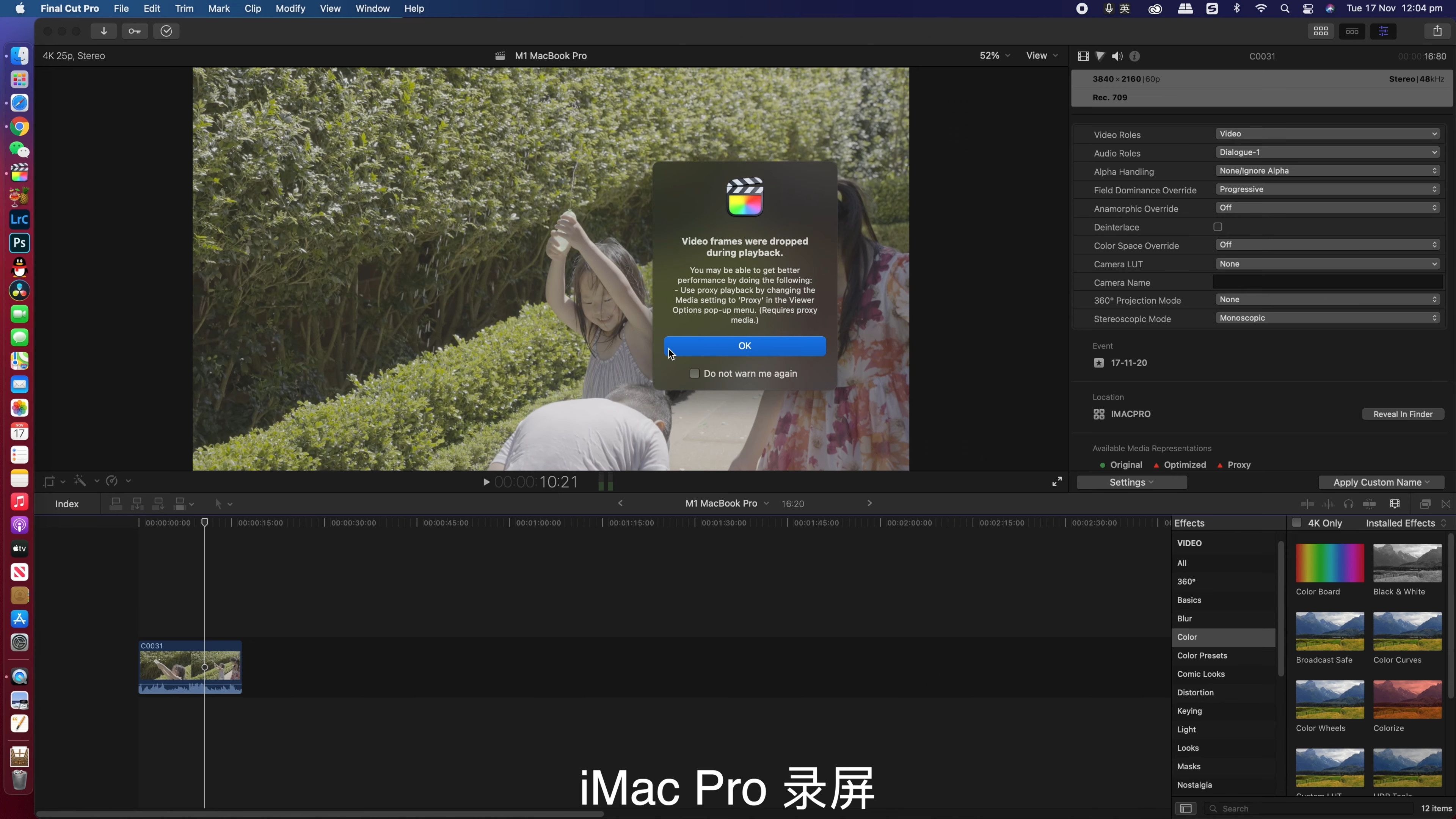The first Apple Silicon Macs have been shipped across the world and the first happy users are starting to play with their new machine. Like this Chinese videographer who detailed his experience in Final Cut Pro with a 13-inch MacBook Pro equipped with 8 GB of RAM, a basic model therefore. He compared this laptop that starts at $ 1,449 to his main Mac, an iMac Pro equipped with 128 GB of RAM, a machine that starts at $ 7,779.
Despite this debauchery of resources, the iMac Pro could not do anything against the power of the Apple M1. Even though the all-in-one is better equipped on all points, with more processor cores (ten minimum), much more RAM and above all a high-end dedicated graphics card (AMD Radeon Pro Vega 56) which has its own dedicated memory (8 GB), the 13-inch MacBook Pro systematically exported the videographer’s various projects more quickly.
The Mac Apple Silicon did better on export, with a widening gap, the more complex the video. For example, exporting 10-bit 4K H.264 video is about 11% faster on the MacBook Pro, but exporting H.265 video in 8K is… 163% faster than on the iMac Pro! ???? The All-in-One was more than twice as slow on this task, completed in just over a minute on the Apple M1 Mac compared to two minutes and 47 seconds on the Intel Mac.


The huge gap on H.265 videos between the iMac Pro and the MacBook Pro is due to the lack of hardware conversion on the all-in-one. Intel’s processor only natively supports H.264 and in the absence of hardware support, its scores are significantly worse.
Among all these tests, it is the one in H.264 which is the most correct to compare the two machines and even then, the Apple M1 comes out ahead. And then, this is one of the advantages of this chip created by Apple, a company that manages both hardware and software. The components have been carefully chosen according to the specific needs of Macs, which gives it its undeniable advantage.
To know more :
The MacBook Pro is also better just for playing video files smoothly in Final Cut Pro. As the videographer shows in his video, the iMac Pro fails to keep pace and even displays an error message on the video at 100 fps. During intensive assembly work, the MacBook Pro also experienced some similar slowdowns, but much less and without causing the error message to appear.

The performance is all the more impressive as the MacBook Pro used here has 8 GB of RAM, it is not even the model with 16 GB as an option. Apple had insisted during the keynote on the advantages of having shared RAM and placed directly next to the other components, we may be starting to see the effect. Although a 16 GB model could do even better, one can also imagine that the amount of RAM will not be as much of an issue on Apple Silicon Macs.
Still not enough to convince you? So be aware that the portable Mac’s fan was completely silent while editing an H.265 video. It might be spinning to keep the chip performing well, but not fast enough to be audible. This bodes well for lovers of silence, and perhaps even for the MacBook Air and its passive cooling.
Moreover, this other video of an Australian user measures an identical time to export with iMovie an H.264 1080p video on the two Apple M1 Macs. A fairly easy exercise, but which shows that for simple uses, the MacBook Air could do well, even in video editing. And on another video where it takes a performance measurement with Cinebench, the MacBook Pro doesn’t sound its fan and it stays barely warm, despite being a very demanding task and lying on a carpet, the worst for its cooling. The final scores between the two machines are very close.
Going back to the Chinese videographer and Final Cut Pro, he also points out that the battery level was nowhere near going down as quickly on his 13-inch MacBook Pro as on the 16-inch model he previously used on the go. While editing the 8K video encoded in H.265, it lost about 15% of the battery on the Mac Apple M1. For comparison, he estimates his 16-inch MacBook Pro would have lost 40 to 50 percent of its capacity on the same task.
While this is great news for the chip created by Apple, he also notes that there are still some youthful bugs related to the transition. During editing, it had several bugs: the sound cut off on the MacBook Pro at one point and Final Cut Pro crashed at another too. He finally notes that AirDrop did not seem to be working. A good reminder that a change in architecture is not trivial and that you should wait a little bit if you don’t like bugs.
These youthful defects removed, these first tests in real conditions should finish convincing the most skeptics. The Apple M1, a chip designed for entry-level Macs, can already do much better than a professional machine five times more expensive for editing and exporting videos. So imagine the more powerful variation expected in the spring and that of next year …
*We just want readers to access information more quickly and easily with other multilingual content, instead of information only available in a certain language.
*We always respect the copyright of the content of the author and always include the original link of the source article.If the author disagrees, just leave the report below the article, the article will be edited or deleted at the request of the author. Thanks very much! Best regards!
These were the details of the news Apple M1: MacBook Pro does better than iMac Pro in Final... for this day. We hope that we have succeeded by giving you the full details and information. To follow all our news, you can subscribe to the alerts system or to one of our different systems to provide you with all that is new.
It is also worth noting that the original news has been published and is available at en24 news and the editorial team at AlKhaleej Today has confirmed it and it has been modified, and it may have been completely transferred or quoted from it and you can read and follow this news from its main source.




